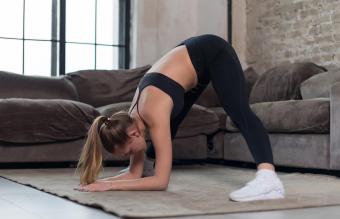
The combination of asthma and hot yoga class sparks much debate as to whether it is harmful to those who suffer from the respiratory condition. Traditionally, the breathing techniques used by yoga practitioners help people with asthma if practiced regularly, but few of us can control the atmospheric conditions of the studio.
Atmosphere Triggers for Asthma
Asthma is associated with a long list of flare triggers, but not all people who suffer from the ailment experience the same symptoms. However, the two documented atmospheric conditions that affect the majority of people with asthma are cold air and high humidity.
Most of us take natural breaths through the nose, and the air is warm and moist. Cold air irritates the lungs, constricts airways, and makes breathing difficult.
When conditions are humid, it's more difficult for the body to lower the core temperature. This struggle increases the flow of oxygen, and some people may experience an asthmatic episode because the lungs can't meet the demand for air. Humidity above 75 percent could be a catalyst to a flare-up.
Some doctors believe that as heat increases the body's metabolism, this spikes the need for more oxygen, and some people have an asthma attack as a result. However, there are few studies to support this theory at this time.
Asthma and Hot Yoga Class: What to Know
There are three main yoga styles that use a warmer-than-average room for yoga: Bikram Yoga, Power Yoga, and Hot Yoga. Other styles are usually performed in studios with temperatures at a comfortable 70-80 degrees. With the three hot styles, you can expect the studio temperature to vary between 80 and 115 degrees. These styles use a warmer room for many reasons, including stimulating detoxification and making the muscles more flexible.
However, there is some debate about the level of humidity in studios with Bikram Yoga, Power Yoga, and Hot Yoga. Many yoga teachers believe the best level of humidity is between 60-70 percent, while others may humidify the room to as much as 85 percent.
So it's possible that if you have asthma, you may not have a reaction in a heated room if the temperature is above 80 degrees, but the humidity is more like 60 percent. From personal experience, this writer has exercise-induced asthma, and has performed Bikram yoga routines a number of times without breathing problems.
What you need to remember about managing asthma and hot yoga classes is the pranayama exercises performed during the warm-up portion of the routine expand the airways. These exercises should be a daily ritual not only to improve your yoga practice, but also to reduce inflammation in the airways and increase oxygen flow.
Other factors to consider when performing one of the hot yoga styles:
- Talk to your health practitioner before taking a class to assure your medication management is accurate for your current condition.
- Always have your quick-relief inhaler with you in the event of an asthmatic flare during practice.
- Inform your instructor about your condition, and ask to be placed in the "cool spot" of the studio. Every room has an area like this.
- Acupuncturists and proponents of Chinese medicine believe that dairy products increase the dampness in our bodies, and this can affect the lungs. Refrain from dairy on the days you practice heated yoga to see if you notice a difference.
Does a heated yoga practice help alleviate asthma symptoms? It's hard to say, but some believe yoga does help asthma sufferers.
Exercised-Induced Asthma
People who have difficulty with asthma and a hot yoga class might be suffering from exercise-induced asthma. The physical activity and the attempt of the lungs to supply more oxygen trigger a flare-up; not so much the air or the temperature. Some people experience problems breathing as little as five minutes into exercise, while others have an asthmatic attack after a workout.
Exercised-induced asthma is a legitimate condition. If you're suffering symptoms, consult your health practitioner and avoid situations that may cause a reaction.







